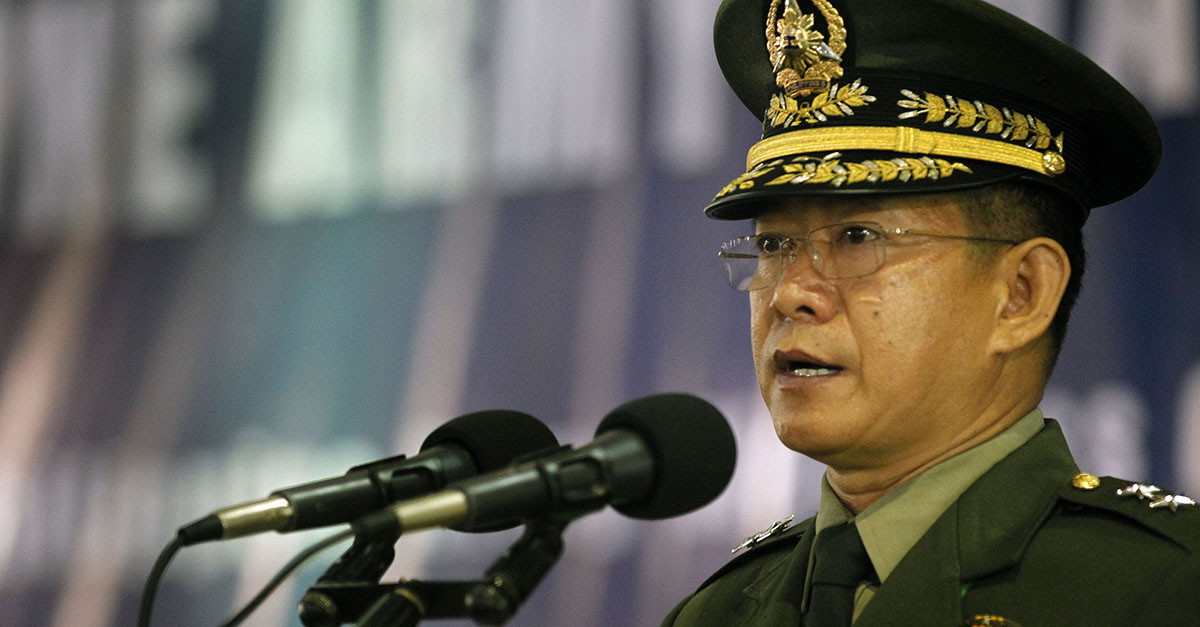A seasoned intelligence officer and respected leader takes the helm of the Armed Forces.

As in a changing of the guard, the Armed Forces of the Philippines (AFP) held a turnover ceremony on December 7, 2016, at Camp Aguinaldo. President Rodrigo Duterte led the ceremonial turnover.
There had been a lot of speculation on who would replace outgoing chief of staff, General Ricardo Visaya who is bowing out of service at the age of 56.
The strongest contender was Army Lieutenant General Ray Leonardo Guerrero, the commanding general of military forces based in the president’s home region, designated as the military’s Eastern Mindanao Command (Eastmincom). He ensured that the ceasefire with communist rebels was sustained under his command even if the forces of the New People’s Army (NPA) are strongest in his area.
The Board of Generals sent 11 names of qualified three-star generals; it is up to the president to choose, based on his trust and confidence.
In the end it was Lieutenant General Eduardo Año who was appointed as the new Chief of Staff of the Armed Forces of the Philippines. The decorated soldier will be serving for ten months. He is scheduled to retire by October 2017 upon reaching the retirement age of 56.
Año graduated from the Philippine Military Academy Class of ’83; he was classmates with the outgoing chief of staff. He served as a commander of the 201st Brigade, 2nd infantry division, and was a commanding general of the Army’s 10th Infantry Division, which had overseen operations over the Davao region and parts of Region 12. He is a seasoned combat and intelligence officer, prior to this Army command he was chief of the Intelligence Service of the AFP. He also served as commander of the army’s Intelligence Security Group (ISG).
During his leadership in the 10th Infantry Division, an operation was launched that led to the killing of Leonico Pitao, known also as Kumander Paragao, the highest and most influential NPA leader in the Davao region.
He excelled in intelligence work, which resulted in the capture of top NPA leaders Benito and Wilma Tiamzon, and Andrea Rosal. To them, Año is known as a rebel hunter. The spouses Tiamzon are now out of detention as part of the rebel panel holding peace talks with the current administration.
But Año also led the hunt and eventually arrested retired Major General Jovito Palparan, a sworn enemy of leftists and communist rebels, who is accused of kidnapping and torturing student activists Karen Empeño and Sherlyn Cadapan.
Año’s climb up the military hierarchy is not without controversy. During the administration of then President Gloria Macapagal-Arroyo, he was allegedly involved in the disappearance of Jonas Burgos, an activist. It will be noted that it was during this administration that the military was held responsible for a wave of killings and disappearances of political activists.
Año has denied any involvement in the disappearance of Burgos, whose name is a rallying cry of his fellow activists. The courts eventually cleared Año of charges; but the Court of Appeals ruled that the military was accountable for the enforced disappearance of Burgos.
The new chief of staff of the 120,000 or so strong Armed Forces of the Philippines vowed to go after lawless elements such as the Abu Sayyaf Group and the Maute Group. “As your AFP Chief, I will lead our transformation with fervor to realize our vision of a strong, modern, and credible Armed Forces, a source of pride of the Filipino people …I am determined to lead the AFP in this endeavor by pushing forward the modernization of our internal security and territorial defense capabilities,” he said.
Año’s appointment didn’t come out of nowhere. Although the majority expected Guerrero to take the AFP helm, Año is still a justifiable, even the natural choice, as the most senior among the nominees. However, being left with less than a year as CSAFP, the revolving door practice may continue to have negative impact to the medium- and long-term strategies of the AFP.





